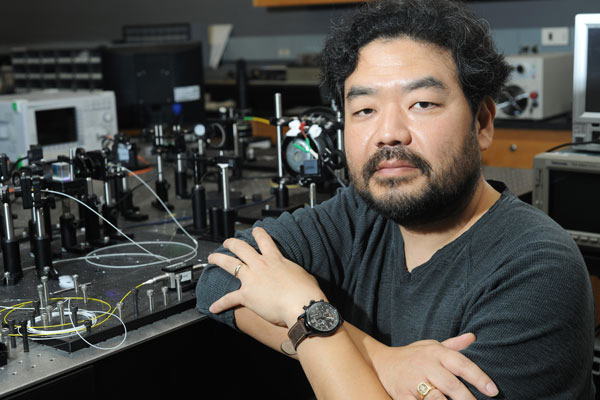Dayton Engineer

Laser Focused Research
By Meagan Pant, assistant director of news and communications
“Pulsed lasers are useful in medical applications, but the type being used now — solid crystal based lasers — are too bulky, too expensive and not easy to use,” said Chong, associate professor of physics. “If they don’t work, it can take even an expert a day or so to get one up and running.”
Chong is focused on pulsed fiber lasers, also known as mode-locked fiber lasers, which are cheaper, smaller and more user-friendly. He is working to create such a laser that generates visible wavelengths, which could be used for microsurgeries, imaging biopsies or even in eradicating cancer cells with gold nanoparticles.
“For medical purposes, we do believe the mode-locked fiber lasers are the future,” he said. “But for now, the visible wavelength laser is not directly available from mode-locked lasers. You have to start with the laser and convert to the visible wavelength. What I’m suggesting is that we build a laser that can generate visible light and make it readily available for medical applications in a way that is cheaper and more reliable.”
Chong’s work is funded for three years and contributes to the more than $3 million of NSF research being conducted by College of Arts and Sciences faculty.
“Dr. Chong has become an internationally recognized leader in mode-locked fiber laser design,” said John Erdei, chair of the University’s physics department. “Our undergraduate and graduate students are fortunate to have the opportunity to learn from him and work alongside him. The experience will be transformative for their education and their future careers.”
Chong began working on his laser research as a doctoral student at Cornell University. He has continued his scientific investigation during his six years as a UD faculty. He was inspired to work in this field, he said, by the possibility to improve lives.
“I thought about a person with a brain tumor,” he said. “Most likely, doctors are going to take out the tumor as much as they can. At the same time, they have to carve out a lot more tissue surrounding it just to make sure all the damaged cells are somehow removed from the brain. And that actually limits the function of the brain.
“But what if we can see the details of the cell structure? Doctors will have a precise idea where to cut and to preserve a lot more brain function of the patient, so they can have a much better life after that. That was my dream project using lasers and imaging.”
Chong said he hopes to collaborate more with experts in the fields of biology and medical research in the future.
“I can provide the laser, so if anyone is interested in doing collaborations I would love to have that chance,” he said.
For more information, contact Meagan Pant, assistant director of news and communications, at 937-229-3256 or mpant1@udayton.edu.


